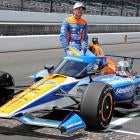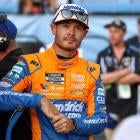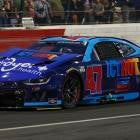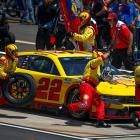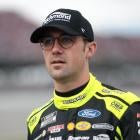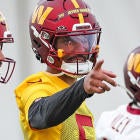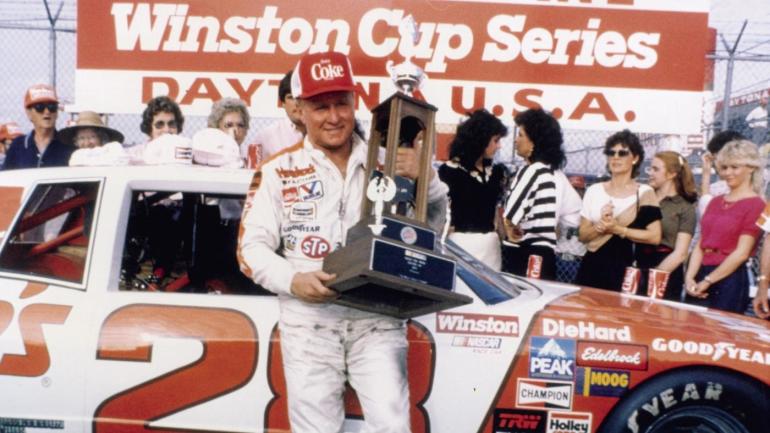
At journey's end, there is a major distinction between having been alive and having lived. NASCAR Hall of Famer Cale Yarborough, by all metrics, surely falls into the latter category.
Yarborough, one of the greatest drivers in the history of NASCAR and a man whose legendary toughness earned him fame and notoriety far beyond the tobacco farms of his native South Carolina, died on New Year's Eve at the age of 84 following a long illness. What he leaves behind are countless stories true to his persona, many of which played out on a racetrack. Yarborough was the first driver to ever win three-straight NASCAR Cup Series championships from 1976 to 1978, and his 83 career wins are tied for sixth on NASCAR's all-time wins list.
Here is a collection of the greatest moments of Cale Yarborough's life and career, ranging from his major victories and triumphs to moments that illustrated to everyone the exceptional toughness that made him the racer and man he was.
1965: Leaving the ballpark at Darlington
Darlington Raceway was central to Cale Yarborough's racing career, as it was there where he got some of his earliest exposure to racing as a local kid sneaking into the Southern 500 to watch the race without a ticket. Years later, the Timmonsville, S.C. native would make his NASCAR debut in the 1957 Southern 500, and by 1965 had become a young driver on the rise in the sport's Grand National division.
After earning his first career win earlier in the year at Valdsota 75 Speedway, Yarborough earned a ride in Banjo Matthews' car for the Southern 500 and was right in the thick of a three-car battle for the lead with Sam McQuagg and Darel Dieringer. On Lap 118, Yarborough attempted to pass McQuagg to the inside entering Turn 1, but the two cars collided, sending McQuagg into the guardrail and Yarborough up and over the top of his car -- clearing the guardrail and sending Yarborough out of the track and tumbling down the embankment on the other side.
Yarborough's crash remains one of the most spectacular in NASCAR history, but he emerged from his car without a scratch and made his way back to the inside of the track and pit road, where he quipped that he "sailed through the air like an astronaut." Ned Jarrett went on to win the race by 14 laps, the largest margin of victory in NASCAR history.
1968: Wins in the Daytona 500 and Southern 500
While the mid-1960s saw a gradual ascent in prominence for Yarborough -- particularly after he joined the Wood Brothers late in the 1966 season -- 1968 would be the point where he truly broke out as one of racing's top drivers. Yarborough won six times in 1968, starting with his first Daytona 500 triumph and culminating in one of the most cherished wins of his career.
After winning the Firecracker 400 for his first Daytona win in 1967, Yarborough came back for Speedweeks to lead a race-high 76 laps before ultimately prevailing in a duel with LeeRoy Yarbrough. Chipping away at Yarbrough's lead over the final 20 laps, Yarborough would pull off a slingshot move coming to four laps to go, pulling away to earn his first Daytona 500 victory by just over a second.
If Yarborough's Daytona 500 win was a major accomplishment, what would happen come Labor Day Weekend was a watershed moment: Leading the opening lap and putting the finishing touches on his performance over the final 90 laps, Yarborough would earn his first of five total Southern 500 victories, a win that was immediately and always remained deeply special to him.
"The Daytona 500 has always been big," Yarborough would say years later. "But my win at Darlington in 1968 ... I would take it over any Daytona 500. Because that's where it all started for me."
1970s-1980s: Journeys to Indianapolis and Le Mans
In addition to his NASCAR career, Cale Yarborough also made exploits in other forms of racing, most notably with four starts in the Indianapolis 500. Yarborough ran both the 1966 and 1967 Indy 500 (failing to finish both due to crashes), but his most notable trips to Indianapolis would come in 1971 and 1972. After Ford pulled factory support for NASCAR, Yarborough would spend two years focusing on USAC racing, driving in back-to-back Indy 500s for car owner Gene White. Yarborough would finish 16th in 1971, then came back the next year to earn a 10th-place finish in 1972 -- his first and only top 10 at Indianapolis before he returned to NASCAR full-time in 1973.
In 1981, Yarborough also made one start in the 24 Hours of Le Mans, driving a Chevrolet Camaro IMSA GTO for U.S.-based Stratagraph Inc. Starring alongside fellow American drivers Billy Hagan and Bill Cooper, Yarborough would complete the first 13 laps before a crash brought an early end to the team's race.
1976-78: Three-straight Cup titles
After returning to NASCAR from USAC, Yarborough would run the 1973 and 1974 seasons for car owner Richard Howard before his team was purchased by the one and only Junior Johnson. With Johnson assuming control midway through the '74 season, Yarborough would earn a career-high 10 wins and finished second in the Winston Cup championship standings, signaling what was to come for the rest of the competition over the next several years.
Yarborough was almost unstoppable from 1976 to 1978, winning 28 times in that span -- nine wins in both 1976 and 1977 and 10 wins in 1978 -- and becoming the first driver in NASCAR history to win the Winston Cup title in three-straight seasons. Those victories included a second Daytona 500 triumph in 1977, a fourth win in the Southern 500 in 1978, and a victory in the Winston 500 at Talladega that same year.
1979: The finish and the fight at Daytona
Coming off his third-straight Cup title in 1978, Cale Yarborough would be a central figure in the 1979 Daytona 500, which introduced NASCAR to a national audience through the first ever live, flag-to-flag telecast of the event on CBS Sports. He would be denied the checkered flag, but what Yarborough did next would wind up capturing the imagination of the television audience and became a defining moment for the very sport of NASCAR itself.
After tangling with Donnie and Bobby Allison while racing for the lead early, Yarborough would take advantage of one of the fastest cars in Daytona to come back from several laps down and settle the race between himself and Donnie Allison in the closing laps. Going down the backstretch on the final lap, Yarborough attempted to slingshot, but Allison took a defensive line that forced Yarborough into the infield. Yarborough then slid into Allison's car, and the two proceeded to collide and slide into the outside wall in Turn 3, ending both of their chances to win.
With Richard Petty having driven past to win the Daytona 500, an angry Yarborough emerged from his car and began yelling at Bobby Allison -- who had pulled over to see if his brother needed a ride back to the pits -- that the wreck was his fault.
"I think I questioned his ancestry, which I shouldn't have done, and he came running toward me and stopped out there a few feet and yelled some more and I think I probably questioned his ancestry a little further, and he lunged at me and he hit me in the face with his helmet," Allison said in 2010. "Boy, the blood dripped to my lap and it hurt and it surprised me. It just really confused me. I thought, you know, I've got to get out of this car and address this situation right now, and so I did."
The moment CBS cameras cut to the fight, the television audience was enthralled and NASCAR was put on the map, setting it on the path that has now taken stock car racing to being America's most popular form of motorsports. Yarborough and the Allison brothers were all fined $6,000 apiece, but that discipline was more of a procedural matter for NASCAR leadership, who realized just what the tussle had done for their sport.
"Fine 'em, you ask? Hell, man, I might just give 'em a bonus," Bill France Jr. told reporters after the fact. "You can't buy publicity like that."
1983: Winning the Daytona 500 in a show car
After driving two seasons for M.C. Anderson in 1981 and 1982, Yarborough joined Ranier-Lundy to drive their No. 28 Chevrolet starting in 1983, aligning himself with NASCAR Hall of Fame crew chief Waddell Wilson and his powerful motors. It took only one lap of qualifying for the strength of that combination to be made clear: Yarborough's first lap of qualifying was 200.503 mph, breaking the 200 mph barrier and setting a NASCAR record for a qualifying lap in the process.
Yarborough tried to push the car even further on his second lap, but he ended up pushing too far. Yarborough's car spun in Turn 4, flipping over once before hitting the outside wall and coming to rest in a crumpled heap on the inside of the track. The team had no backup car on hand, causing them to have to scramble to find one. They did so in the parking lot of a nearby Hardee's restaurant, which was displaying a show car of Yarborough's Hardee's-sponsored machine -- on a Pontiac LeMans -- for promotional purposes.
After his crew thrashed to get the car race-ready, Yarborough would finish third in his Twin 125 qualifying race before a dramatic finish on Sunday. With a CBS in-car camera on-board -- picking up Yarborough making his own race car noises in a zen-like state -- Yarborough pulled off a slingshot on Buddy Baker with half a lap to go and made it back to the checkered flag for his third Daytona 500 win.
The next year, this time without a show car, Yarborough did the same thing again, this time putting the last lap slingshot on Darrell Waltrip to win his fourth Daytona 500. To this day, Yarborough is one of only two drivers to have ever won the Daytona 500 more than three times, with his four wins second only to Richard Petty's seven victories.
1997: Victory as a car owner
As he transitioned from one part of his racing career to the next, Yarborough would demonstrate an eye for driving talent as a NASCAR car owner. In his final season in 1988, Yarborough would split the No. 29 he owned with a young and still-fledgling Dale Jarrett, who took over the car full-time the next season. Yarborough would bring Dick Trickle aboard in 1990, oversaw Jimmy Hensley winning Cup Rookie of the Year honors in 1992, and launched the career of future Cup Series winner Jeremy Mayfield -- this after he had tried to lure a young Jeff Gordon to drive for his team some years earlier.
Cale Yarborough Motorsports' crowning moment would come in the 1997 Pepsi 400 at Daytona, when John Andretti led 113 of 160 laps and survived a one-lap shootout to earn his first career win and the only win for his race team, holding off the likes of Jarrett, Dale Earnhardt, Terry Labonte and Sterling Marlin in the process. Yarborough's team would have 13 top fives, 32 top 10s and three poles in total before he sold the operation following the 1999 season.
2008: Passing the torch
In all, Cale Yarborough finished his NASCAR career with three Cup championships and 83 career victories. In the process, Yarborough would capture the imagination of a young admirer from out west.
Growing up in El Cajon, Calif., Jimmie Johnson came to idolize Cale Yarborough, and he would end up both matching and in some ways exceeding his boyhood hero. In 2008, after Johnson tied Yarborough's mark of three-straight Cup championships, Yarborough would honor Johnson at the year-end champion's banquet by presenting him with his championship ring.
Johnson would later surpass Yarborough's mark with five-straight championships, but the two would end up together in the record books again when Johnson earned his 83rd career victory at Dover in 2017, tying him with Yarborough for sixth on NASCAR's all-time wins list.
"I was a big Cale Yarborough fan, and I remember going to a race in Oklahoma with my parents and my brother -- we were driving across the country and we pull up to a Hardee's, had no idea it was a burger stand, and I really thought when I walked in the door that I was going to Cale Yarborough's race shop. It was very disappointing. I had a burger and left and then understood the world of sponsorship," Johnson said in Victory Lane. "To be here, to tie him at 83 wins ... Cale, you're the man. Thank you for all you've done for our sport."
Cale Yarborough was my childhood hero. What an honor to be tied with the legend for 83 Cup series wins. He was “the man” and the legacy of Cale Yarborough will forever live on. My deepest condolences to Cale’s family. pic.twitter.com/xcikjl2pu6
— Jimmie Johnson (@JimmieJohnson) December 31, 2023














